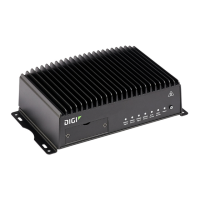System settings Update system firmware
Digi TransPort WR Routers User Guide
242
Manage firmware updates using Digi Remote Manager
If you have a network of many devices, you can use Digi Remote Manager Profiles to manage
firmware updates. Profiles ensures all your devices are running the correct firmware version and that
all newly installed devices are updated to that same version. For more information, see the Profiles
section of the Digi Remote Manager User Guide.
Failover and recovery during system update
TransPort devices are capable of storing two firmware images in flash memory. Additionally, the
device stores a "boot bit" in flash memory, which the bootloader uses to determine which firmware
image to load when the system restarts. The following workflows describe the process involved in
downloading a new firmware image, validating the image, installing the image, and changing the boot
bit to indicate that the new image should be use at startup:
n Firmware update process using the Web UI:
1. The selected firmware image is downloaded from the Digi Repository or the user’s PC.
2. The firmware image is validated by checking the signature of the firmware image.
l If the firmware is invalid either through a corrupted firmware download, or an
invalid signature, the firmware update process is aborted and the device will
continue to run the existing firmware.
l If the firmware is valid, the firmware image is unpacked and the firmware image is
stored in the unused firmware banks.
3. The boot bit is toggled, so that the new firmware image is loaded when the device next
reboots.
n Firmware update process using the command line:
1. The user downloads the firmware from the Digi support site.
2. The user copies the firmware image onto the device using SFTP or SCP.
3. The user initiates the firmware update, using the update firmware command.
4. The firmware image is validated by checking the signature of the firmware image.
l If the firmware is invalid either through a corrupted firmware download, or an
invalid signature, the firmware update process is aborted and the device will
continue to run the existing firmware.
l If the firmware is valid, the firmware image is unpacked and the firmware image is
stored in the unused firmware banks.
5. The boot bit is toggled, so that the new firmware image is loaded when the device next
reboots.
Firmware update failure scenarios
The following are examples of situations where the firmware update process might fail, and how the
TransPort device recovers from that failure:
n Loss of internet connectivity while downloading firmware.
The firmware update process will timeout and the device will continue to run the existing
firmware image without rebooting. If the device is subsequently rebooted, it will continue to
use the existing firmware image.

